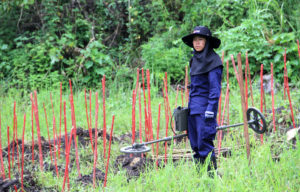
CC BY Samuel Huron
More forest in the world’s largest nations
The two biggest countries in the world are no longer cutting down on their forests. On the contrary, they are planting more trees than they fell, and their forests are increasing. Many other countries have also realised that this green growth is a good investment for both nature and economy.
Share
The Great Green Wall of China
China is not only planting forest due to concerns about economy, nature, and climate change. The legions of trees are also soldiers on the frontlines of China’s war against the deserts that keep growing, destroying farmland and polluting the air with enormous duststorms.
A project to combat desertification, unofficially called the ‘Great Green Wall of China’, began in 1978. The aim is to stop deserts from spreading by planting 364,217 square kilometres of forest before 2050. The work is done both manually by planting millions of saplings and from the air by carpet-bombing huge tracts of land with seeds.
This reforestation project has met with a lot of criticism, also within China. Scientists have warned that the types of trees used are not suitable to the local soil conditions, and that planting large areas with only few species of plants will lead to environmentally poor and fragile forest. A study has shown that most of the small trees die before their roots have a chance to take hold, and that many of the survivors later wilt, because the roots of the unsuitable tree species deplete the scarce desert water too quickly.
Chinese ecologists recommend that the project design be fundamentally adjusted, and smaller projects have now been launched to test whether it will give better results to use a more natural and mixed selection of trees and other plants.
Other categories
Every third human being lives in India or China, but despite great progress in recent years, many people still live in abject poverty in these enormous nations. For this reason, it might seem obvious that they would be quick to reach for the axe and cut down their trees for a quick profit.
But this has not happened, and in fact the planter’s shovel has been working faster than the chainsaw for the last 20 years, according to statistics from the United Nations World Bank.
In total, forests have increased by more than 572,000 km2 in India and China since 1990. That corresponds to an area the size of France. Many other countries have also started doing the same thing, causing forests to increase in Great Britain, Chile, Vietnam, Turkey, Spain, France, and Poland, among others.
If we focus on the nations with the largest forest areas – Russia, Brazil, Canada, USA, and China, we find that it’s actually only Brazil that still keeps on losing forest. In the United States, the forests are increasing slightly each year, while both Russia and Canada maintain the status quo, with forests neither growing nor shrinking.
Forests are green goldmines
It has proved a sensible investment for countries to maintain and profit from the use of their forests in a sustainable way, year after year. The UN Food- and Agricultural Organisation (FAO) has estimated that the yearly economic benefit from the world’s forests amounts to almost 730 billion US dollars. The forests provide food, employment, access to energy, construction materials, and a host of other benefits that boost the economy in one way or another.
According to the FAO, since 2007 there has been a tendency for countries to see sustainable forestry as a national political goal. Many countries have taken substantial strides in defining who has the rights to their forests, and how they should be used.
Vietnam leads the way
Today, governments can look to international standards that define what sustainable forestry actually means in practice. For example, these standards call for planting at least as many trees as are cut down, animal life is to be protected, and forest workers must have safety equipment, access to education, and decent wages. However, the FAO acknowledges that policy and reality are still two different things in many countries.
The difference becomes apparent when we compare countries like Vietnam and Honduras. Both are tropical nations with about 17 percent of the population living in extreme poverty. But whereas Honduras has cut down large parts of its rainforest in the last 20 years, Vietnam has gone in the opposite direction, and today has 47 percent more forest than in 1990.
This great forest growth seems to be rooted in Vietnamese policy changes through the nineties, transferring ownership of forest from the state to local communities. This gives good results, according to a report from Center for International Forestry Research. When local people own their own forest, they are more likely to preserve and maintain it. The report concludes that local ownership is at least as effective to protect forest as keeping the forest on state hands and declaring it a protected nature reserve.
But legal changes are not enough. The law also has to be enforced, and the consequences of not doing that become apparent when looking at Honduras.
“In Honduras they also have a social forestry management programme going, and we are working to strengthen that,” says Jakob Ryding, technical adviser at the Danish NGO Forests of the World.
Nevertheless, statistics show that the country has lost 37 percent of its forest since 1990, and the tree loss seems to continue.
“The problems in Honduras have a lot to do with a lack of resources for the forest authorities, which means that Honduran authorities cannot carry out any meaningful monitoring of the forests and act against deforestation by poor people seeking land for farming,” Jakob Ryding elaborates. He also notes that there is another reason for much of the forest loss in Honduras. The country struggles with crime, and large criminal organisations are buying up forest. They then convert the land into oil palm plantations, with the covert aim to launder money made by drug trafficking.
Rainforest still under threat
If we zoom out from the situation in Honduras and Vietnam to look at the global picture, statistics show that forests on Planet Earth are still shrinking. However, they are only shrinking half as fast now as they did in the nineties. From 1990 to 2000, the world lost 0.2 percent of its total forest each year. From 2000, the speed of logging fell to 0,1 percent annually. Simplified a bit, this means that we each year lose one tree out of every thousand.
Slower logging and more sustainable forestry is good news, considering the big benefits that forests can bring to both nature and people. But there are still big unsolved challenges. Deforestation and reforestation are unevenly distributed throughout the world, with the countries clearing the most forest also being countries with tropical rainforests. These ancient and highly specialised woodlands would need an extremely long time to regrow, if it’s even possible at all. Though many countries are now profiting from using and managing their forests without clearing them, at the end of the day it’s a political question if we humans decide to leave some nature untouched and without economic benefit to us.
“It’s important to mention that even though sustainable forestry can work well, it doesn’t mean that we should use all the world’s forest in this way. Some areas should be left intact and untouched by man,” says Jakob Ryding from Forests of the World.







